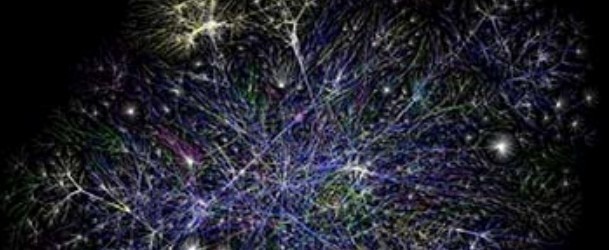The how and why of the quantum internet

(DataCenterDynamics) The quantum informatics community is already hard at work on the next step beyond individual quantum computers: an Internet that can connect them to work together. Peter Judge of DataCenterDynamics has composed this extensive discussion of the technologies and key players developing the quantum internet. Inside Quantum Technology summarizes but the full article is well-worth the time to review and read in full by clicking on the source link.
We can already communicate with plenty of experimental quantum computers on the Internet. For instance, Amazon’s AWS Braket lets you build and test quantum algorithms on different quantum processors (D-Wave, IonQ, or Rigetti) or use a simulator. Microsoft does something similar on Azure, and IBM also lets users play with a five-qubit quantum system.
Sharing the output of isolated quantum computers is one thing; linking quantum computers up is something else.
Why link up quantum computers?
“It is hard to build quantum computers large enough to solve really big problems,” explains Vint Cerf, one of the Internet’s founders, in an email exchange with DCD.
The problem is harder because the quantum world creates errors: “You need a lot of physical qubits to make a much smaller number of logical qubits – because error correction requires a lot of physical qubits.”
We actually do need to make our quantum computers bigger.But we want to link “live” qubits, rather than just sharing the quantum computer’s output. We want to distribute the internal states of that computer without collapsing the wave function – and that means distributing entanglement (see box)
The quantum Internet takes quantum effects and distributes them across a network. That turns out to be very complex – but potentially very powerful
The quantum Internet means taking quantum effects and distributing them across a network. That turns out to be very complex – but potentially very powerful.
“Scaling of quantum computers is facilitated by the distribution of entanglement,” says Cerf, who works at Google. “In theory, you can make a larger quantum system if you can distribute entanglement to a larger number of distinct quantum machines.”
We are beginning to see the start of a quantum Internet.
Send for the standards body
Numerous entities and governments working on the quantum internet around the world could create several, incompatible quantum Internets. And that would betray what the original Internet was all about.
The Internet famously operates by “rough consensus and running code.” Engineers make sure things work, and can be duplicated in multiple systems, before setting them in stone.
For 35 years, the body that has ensured that running code has been the Internet Engineering Task Force (IETF). It’s the body that curates standards for anything added to our global nervous system.
Since the dawn of the Internet, the IETF has published standards known as “RFCs” (requests for comment). These define the network protocols which ensure your emails and your video chats can be received by other people.
If we are going to have a quantum Internet, we’ll need an RFC which sets out how quantum computers communicate.
The Internet famously operates by “rough consensus and running code.” Engineers make sure things work, and can be duplicated in multiple systems, before setting them in stone.
For 35 years, the body that has ensured that running code has been the Internet Engineering Task Force (IETF). It’s the body that curates standards for anything added to our global nervous system.
Since the dawn of the Internet, the IETF has published standards known as “RFCs” (requests for comment). These define the network protocols which ensure your emails and your video chats can be received by other people. If we are going to have a quantum Internet, we’ll need an RFC which sets out how quantum computers communicate.
Towards a quantum Internet protocol
In late 2020, Kozlowski co-authored a paper with colleagues at Delft, proposing a quantum Internet protocol, which sets an important precedent, by placing distributed entanglement into a framework similar to the layered stacks – OSI or TCP/IP – which define communication over classical networks.
“Our proposed stack was heavily inspired by TCP/IP, or OSI.” he tells us. “The definitions of each layer are slightly different, but there was this physical layer at the bottom, which was about attempting to generate entanglement.”
That word “attempting” is important, he says: “It fails a lot of the time. Then we have a link responsible for operating on a single link, between two quantum repeaters.
Starting small
The quantum Internet will start local. While the QIRG is thinking about spanning kilometers, quantum computing startups can see the use in much smaller networks, says Steve Brierley CEO of Riverlane, a company impatient to hook up large enough quantum computers to do real work.
“The concept is to build well functioning modules, and then network them together,” says Brierley. “For now, this would be in the same room – potentially even in the same fridge.”
That level of networking “could happen over the next five years,” says Brierley. “In fact, there are already demonstrations of that today.”
Why do it?
At this stage, it may all sound too complex. Why do it?
The big payoff could be distributing quantum computing, but Kozlowski sounds a note of caution: “Currently it’s not 100 percent clear how one would do the computations. We have to first figure out how do we do computations on 10,000 computers, as opposed to one big computer.”
But Steve Brierley wants to see large, practical quantum computers which take high-performance computing (HPC) far beyond its current impressive achievements.
Thanks to today’s HPC systems, Brierley says: “We no longer ‘discover’ aircraft, we design them using fluid dynamics. We have a model of the underlying physics, and we use HPC to solve those equations.”
If quantum computers reach industrial scales, Brierley believes they could bring that same effect to other sectors like medicine, where we know the physics, but can’t yet solve the equations quickly enough.“We still ‘discover’ new medicines,” he says. “We’ve decoded the human DNA sequence, but that’s just a parts list.”Creating a medicine means finding a chemical that locks into a specific site on a protein because of its shape and electrical properties. But predicting those interactions means solving equations for atoms in motion.
Sandra K. Helsel, Ph.D. has been researching and reporting on frontier technologies since 1990. She has her Ph.D. from the University of Arizona.



















